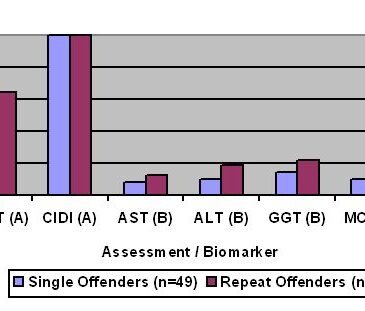DUI offenders exhibit high rates of alcohol use disorders (AUDs); among primarily first-time offenders, more than 85% qualify for alcohol abuse or dependence within the past year; among repeat offenders, the rate is above 98% (Lapham et al., 2001; Shaffer et al., 2007). Certain biomarkers (e.g., high levels of certain enzymes) can detect AUD accurately. These biomarkers, not surprisingly, appear to discriminate DUI offenders from people who do not exhibit DUI behavior. This week, the DRAM reviews a study by Couture and colleagues that attempts to determine whether biomarkers can distinguish between single and repeat DUI offenders (Couture et al., 2010). In the discussion, we compare the results of the Couture et al. study to those of a second similar study (Portman et al., 2010).
Methods
- Participants (n=144) were adult male DUI offenders (i.e., having at least one DUI conviction) drawn from a community sample.
- Each participant gave a blood sample, from which technicians obtained and analyzed the following biomarkers using empirically determined cut points.
- AST, ALT, & GGT (enzymes – high levels associated with AUD)
- MCV (red blood cell volume — large volume associated with AUD)
- CDT (a glycoprotein – high percentages associated with AUD)
- Thiamine (Vitamin B1 – low levels associated with AUD)
- Researchers measured alcohol use problems and disorders using the Michigan Alcoholism Screening Test (MAST – lifetime misuse: Selzer, 1971), Alcohol Use Disorders Identification Test (AUDIT – past 12 month problems: Babor, Higgins-Biddle, Saunders, & Monteiro, 2006), and substance use module of the Composite International Diagnostic Interview (CIDI – lifetime diagnosis of AUD: Kessler & Ustun, 2004).
- Participants’ DUI recidivism status was based on number of DUI convictions (i.e., 1 = single offender; 2+ = repeat offender).
Results
- The proportion of offenders scoring above the cutpoint on the self-report assessments and the biomarkers that indicate alcohol use problems or disorders did not differ for single and repeat DUI offenders (see Figure).
- A logistic regression including all biomarkers as predictors was unable to predict recidivism status (i.e., single vs. repeat DUI offense); scoring above the cut point on two or more biomarkers also did not distinguish repeat from single offenders.

Figure. Percent of single and repeat DUI offenders meeting assessment and biomarker cut points for alcohol use problems and AUDs (adapted from Couture et al., 2010). Note: A = Assessment; B = Biomarker. There were no statistically significant differences between single and repeat offenders. Click image to enlarge.
Limitations
- Participants were all individuals convicted of DUI; these results might not generalize to people who exhibit DUI behavior but are not arrested or convicted.
- Only males were tested, due to the gender-specificity of biomarker cut points.
Discussion
Despite biomarkers having evidenced the capacity to identify AUDs, this study did not find any evidence that biomarkers could predict DUI recidivism. Interestingly, another recent study of male DUI offenders (Portman et al., 2010) replicated these results; in the Portman et al. study, the biomarkers were able to detect recidivism among DUI offenders identified via random breath testing, but unable to distinguish repeat offenders from single offenders among DUI offenders stopped as a result of their DUI behavior. Taken together, the results of these studies suggest that levels of AUD among arrested DUI offenders, even first-time offenders, might be too high for biomarkers to effectively predict additional DUI arrests.
— Sarah Nelson
What do you think? Please use the comment link below to provide feedback on this article.
References
Babor, T. F., Higgins-Biddle, J. C., Saunders, J. B., & Monteiro, M. G. (2006). AUDIT: The Alcohol Use Disorders Identification Test: Guidelines for use in primary care. Geneva, Switzerland: World Health Organization: Department of Mental Health and Substance Dependence.
Couture, S., Brown, T. G., Tremblay, J., Ng Ying Kin, N. M. K., Oimet, M. C., & Nadeau, L. (2010). Are biomarkers of chronic alcohol misuse useful in the assessment of DWI recidivism status? Accident Analysis and Prevention, 42, 307-312.
Kessler, R. C., & Ustun, T. B. (2004). The World Mental Health (WMH) Survey Initiative version of the World Health Organization (WHO) Composite International Diagnostic Interview (CIDI). International Journal of Methods in Psychiatric Research, 13(2), 93-121.
Lapham, S. C., Smith, E., C’de Baca, J., Chang, I., Skipper, B. J., Baum, G., et al. (2001). Prevalence of psychiatric disorders among persons convicted of driving while impaired. Archives of General Psychiatry, 58, 943-949.
Portman, M., Penttila, A., Haukka, J., Erickson, P., Alho, H., & Kuoppasalmi, K. (2010). Predicting DUI recidivism of male drunken driving: A prospective study of the impact of alcohol markers and previous drunken driving. Drug and Alcohol Dependence, 106, 186-192.
Selzer, M. L. (1971). The Michigan alcoholism screening test: The quest for a new diagnostic instrument. American Journal of Psychiatry, 127, 1653–1658.
Shaffer, H. J., Nelson, S. E., LaPlante, D. A., LaBrie, R. A., Albanese, M. J., & Caro, G. (2007). The epidemiology of psychiatric disorders among repeat DUI offenders accepting a treatment sentencing option Journal of Consulting and Clinical Psychology, 75(5), 795-804.





Norman G. Hoffmann, Ph.D. January 19, 2011
Why are researchers still using such an antiquated instrument as the MAST when there are better instruments available?
Sarah E. Nelson, Ph.D. January 28, 2011
Dear Dr. Hoffman,
Thank you for your comment. Obviously, one would have to ask the authors why they chose the particular instruments they did. The MAST is well-validated and has a long history of use. However, it is a lifetime measure which makes it ill-suited for identifying whether alcohol problems are current. In the article we reviewed, the authors, to their credit, used multiple measures of alcohol use problems and disorders. This approach allows for comparison between measures and more confidence in results and patterns that emerge across all assessments.
Best,
Sarah E. Nelson, PhD
Associate Director of Research
Division on Addictions